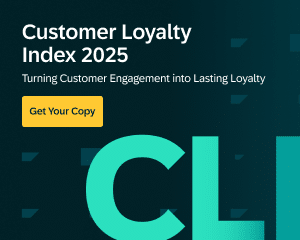Acquiring new customers is harder — and costlier — than ever. In 2025, brands are losing more ground to rising acquisition costs and higher consumer expectations. According to the SAP Emarsys Customer Loyalty Index 2025, true loyalty has declined for the first time in five years, falling from 31% in 2024 to 29% this year. That means almost three-quarters of consumers are open to switching brands.
With loyalty harder to earn and easier to lose, every interaction matters — especially the first one.
That’s where onboarding comes in.
A seamless, thoughtful onboarding experience can be the difference between a one-time buyer and a lifelong customer. It’s your opportunity to deliver early value, reassure new customers they’ve made the right choice, and set the stage for long-term retention.
In this article, we’ll explore five customer onboarding best practices that help you build confidence, deepen relationships, and boost loyalty in 2025.
Why Onboarding is Great for Customer Loyalty
Congratulations! A customer found your company, moved through the sales funnel, and clicked to purchase. You’re probably thinking your hard work has finally paid off. But the path to customer success is just beginning. Will your new customers stay for years, or disappear after a few days?
The moment a prospect becomes a customer, onboarding begins — and that first impression is entirely up to you.
Customer onboarding is your chance to put your best foot forward and make a lasting impression. A positive experience helps customers feel valued, supported, and confident they made the right choice. A poor experience, on the other hand, can quickly send them to a competitor.
Ultimately, great onboarding is the foundation of loyalty and retention. When you earn your customers’ trust early, they’re far more likely to become repeat buyers — and long-term advocates for your brand.
1. Automate Your Welcome Flow to Build Trust from Day One
The first few days after a customer’s purchase are when loyalty begins to form — or fade. If you wait too long to follow up, you risk losing momentum. That’s why a well-timed, automated welcome flow is one of the most powerful tools in your retention strategy.
An automated welcome journey does more than thank customers for their order. It sets the tone for your relationship by showing them what to expect next, delivery updates, loyalty benefits, or helpful tips for getting the most from their purchase.
Keep the flow short, purposeful, and consistent across channels. A typical sequence might include:
- Email 1: A warm thank-you and order confirmation that introduces your brand voice.
- Email 2: Delivery or setup information, plus a gentle nudge toward your community or loyalty program.
- Email 3: A follow-up that highlights how others are using or styling the product — with links to tutorials or social proof.
Automation ensures every new customer receives this experience at the right time, without relying on manual sends. You can also use behavior-based triggers, like whether a customer opens an email or visits your site again, to adapt the content or timing automatically.
Pro tip: Keep your welcome flow to three or four emails over seven to ten days. Prioritize relevance and pacing over frequency, and make sure every message has a clear purpose.
2. Personalize Onboarding with Real Customer Data
No two customers follow the same journey, so your onboarding shouldn’t either. Personalization turns a generic welcome into a meaningful experience, one that reflects who your customer is, what they’ve bought, and what will keep them coming back.
Start by unifying the data you already have: purchase history, browsing behavior, engagement patterns, and loyalty status. This gives you a single view of each customer and lets you tailor onboarding messages to their preferences.
For example:
- A customer who just purchased running shoes might receive training tips or related product recommendations.
- A loyalty member could see points updates and early access to new collections.
- A customer who hasn’t yet engaged might get a simple check-in message offering support or inspiration.
The goal with this kind of personalization is to make your customers feel seen, heard and understood… not targeted. When employed correctly, every message will feel intentional and relevant, and you’ll reinforce that your brand understands them as individuals, not data points.
How SAP Emarsys helps: The SAP Emarsys Customer Engagement platform connects data from across online and offline channels to create a unified customer view. You can then build dynamic segments and trigger personalized onboarding journeys that automatically adapt to each shopper’s behavior and preferences.
3. Use Behavioral Triggers to Keep Communication Relevant
Good onboarding journeys follow a fixed schedule. Great ones follow the customer. Behavioral triggers make that possible.
With behavioral triggers, you can respond in real time to what each person does (or doesn’t do), keeping communication relevant and perfectly timed.
For example, you can trigger messages when customers:
Open or ignore your welcome email. If they don’t engage, send a gentle reminder or introduce another channel like SMS.
Browse products but don’t buy. A well-timed follow-up with inspiration or reviews can reignite interest.
Complete their first purchase. Use that moment to thank them, offer setup guidance, or highlight loyalty benefits.
Go quiet for a few weeks. A personalized “We miss you” email with helpful content or a small incentive can bring them back.
These small, behavior-based moments compound over time. Instead of sending one-size-fits-all emails, you’re reacting to real customer signals — showing that your brand listens, adapts, and respects their attention.
Pro tip: Start simple then scale. Identify three or four key onboarding triggers like “first purchase,” “first login,” or “no activity for 10 days”, and build automated messages around them. Once those are performing well, you can layer in additional triggers to further refine timing and relevance.
4. Connect Onboarding to Loyalty and Retention Programs
Onboarding doesn’t stop once your customer makes their first purchase. It should be treated as the start of an ongoing relationship. The most successful brands use this process as a way to introduce customers to the next step in the journey – exploring complementary products, engaging with the community, or even joining a loyalty program.
When done right, this transition will feel natural. Once your customer has had a positive first experience, they’re more receptive to offers that deepen their connection with your brand.
To put this in action, you might:
Invite new customers to join your loyalty program after their first purchase.
Use their onboarding emails to highlight rewards, points, or early-access perks.
Show how other customers are getting more value through membership.
It’s a powerful moment to build advocacy early. According to the SAP Emarsys Customer Loyalty Index 2025, 68% of consumers say loyalty programs make them more likely to buy again from a brand they trust.

5. Measure, Learn, and Optimize the Onboarding Journey
Email automations are designed to run independently in the background, buying your team time to work on strategy, instead of being buried in execution. However, that doesn’t mean they’re fully “set and forget”.
Even the best onboarding flows can go stale over time. Consumer behavior shifts, preferences change, and that’s why what worked last quarter might not resonate as well today. For this reason, measuring and optimizing your onboarding journey is just as important as launching it.
Start by tracking the right metrics. Not just open and click rates, but customer outcomes. Look for:
- Repeat purchase rate: Are first-time buyers coming back within 30 or 60 days?
- Time to second order: How long does it take a new customer to buy again?
- Engagement drop-off: At what stage do customers stop interacting with your onboarding messages?
- Churn risk: Are there common patterns among customers who disengage early?
Use these insights to refine both timing and content. Test new subject lines, imagery, or channel combinations, and pay attention to what improves conversion from first-time buyer to repeat customer.
Pro tip: Don’t treat onboarding as a one-time campaign. Review its performance quarterly, and update key messages or triggers whenever new data or products launch.
Final Thoughts
Even though the onboarding process is only at the beginning of the journey, it lays the foundation of a fruitful relationship with your customers. A great customer onboarding process helps with customer loyalty and retention. Although a churn might happen, by following these customer onboarding best practices, you can rest assured that your customers will see the full value of your product or service. Ultimately, all of this plays a role in helping you turn your prospects into strong brand advocates, and drive customer loyalty.







